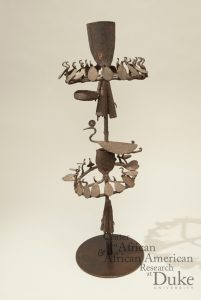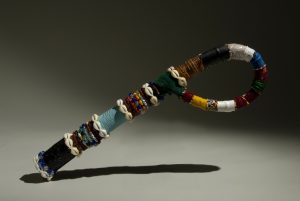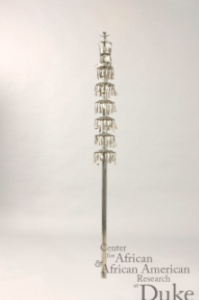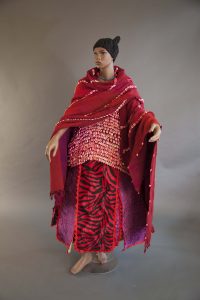Daniel DellaPasqua
Haitian Vodou Ritual
October 12, 2017
A Tase of Haitian Vodou at Fleming Museum
On Thursday, October 12th, I attended a Haitian Vodou ritual in the Fleming Museum. When the ritual began, leader Priestess Marie Maude Evans began prayer. The Priestesses then knelt down in front of a large alter, adjacent to three drummers who began to drum lightly. On the altar sat dozens of sparkling bottles, delicious foods for the gods, candles, pictures, and many other personal altar objects owned by Professor J. Lorand Matory. Once the ritual began, which was gradual, the drummers started to play more intensely. Once this began, the three women performing the ritual started to dance to the rhythm. The women were eventually joined by a crowd of people who began to dance, trying to bring about the Haitian spirits or deities. The dances they were doing, as learned from class, resemble breaking free from slavery and oppression, a plead for freedom.
I read an article by Tim Johnson called “A taste of Vodou at UVM” where he interviews Talibi Adedoyin Faniyi, chief priestess of a temple in Oshogbo, Nigeria. She states, “Dance is very important in the worship, because with dance, through dance … you get in trance, and when you have trance … It’s through dance you get a kind of message from the deity.”
This was the most fascinating part to me, how the drums and dancing intertwined. The drums are the noise which activates the energy or áshe(Yoruba) within the room. As learned from readings in class and lectures from acclaimed scholars, movement and noise is needed in order to activate or bring about energy. The more of these elements you have, the stronger the energy in the room. It gives the ritual a life force to feed from.
Ultimately, the most interesting part of the ritual to me was when one of the woman performing the ritual was possessed by the deity Kalfu. Suddenly, she started dancing out of rhythm with the rest of the practitioners, and it was clear Kalfu had possessed her, inserting his soul into her. When this happens, the body is a vesicle for the god, and they are unaware of what happened during the time of possession. This reminds me, to some extent, of Thompson’s chapter which illustrated Shango spirit possession on page 84. While Kalfu possession is not permanent, you are still housing a spirit within.
Also, the altar used during the ritual had many of the artifacts typical to our readings. The artifact that stood out to me most were the bottles, which I immediately connected to McAlister’s “A Sorcerer’s Bottle.” Although this was not a wanga, the bottles are still vesicles for a god to use, drinking the libations within. Overall the Haitian Vodou ritual was exciting, energetic, and intense. One could physically feel the energy in the air. I think this event was beneficial in better understanding African Diaspora as a whole. Seeing the way which practitioners of these religions interact with their gods is far different than one could contextualize from readings. With this being said, I am glad I chose to attend this event.


 The ibiri, is a scepter-like object carried by the orixa of dance, death, disease and mud; Nanã. Nanã is an orixa of the Brazilian practice of Candomble. The ibiri was said to have been for with Nanã, in the placenta, and the staff itself grew as Nanã aged. However, the staff was placed into the earth, and Nanã was temporarily seperated from it. Until, her son Omolú had found it and brought it back to his mother, and this is what the word ibiri is translated into “Son-found-it- and brought-back-to-me” as found on page 71 in our textbook. The ibiri, is a twin scepter, to the xaxará, the scepter had by Omolú, god of pestilence, and her son. The ibiri is made of a gathered bunch of the ribs of palm fronds, around which is an intricately interwoven net of woven African straw, and adorned with various colored swatches, especially of the colors blue and white, and cowry shells. The colors of blue and white are especially associated with Nanã. The ibiri, is a symbol to the orixa, of when she carried her son in her arms as an infant.
The ibiri, is a scepter-like object carried by the orixa of dance, death, disease and mud; Nanã. Nanã is an orixa of the Brazilian practice of Candomble. The ibiri was said to have been for with Nanã, in the placenta, and the staff itself grew as Nanã aged. However, the staff was placed into the earth, and Nanã was temporarily seperated from it. Until, her son Omolú had found it and brought it back to his mother, and this is what the word ibiri is translated into “Son-found-it- and brought-back-to-me” as found on page 71 in our textbook. The ibiri, is a twin scepter, to the xaxará, the scepter had by Omolú, god of pestilence, and her son. The ibiri is made of a gathered bunch of the ribs of palm fronds, around which is an intricately interwoven net of woven African straw, and adorned with various colored swatches, especially of the colors blue and white, and cowry shells. The colors of blue and white are especially associated with Nanã. The ibiri, is a symbol to the orixa, of when she carried her son in her arms as an infant.



